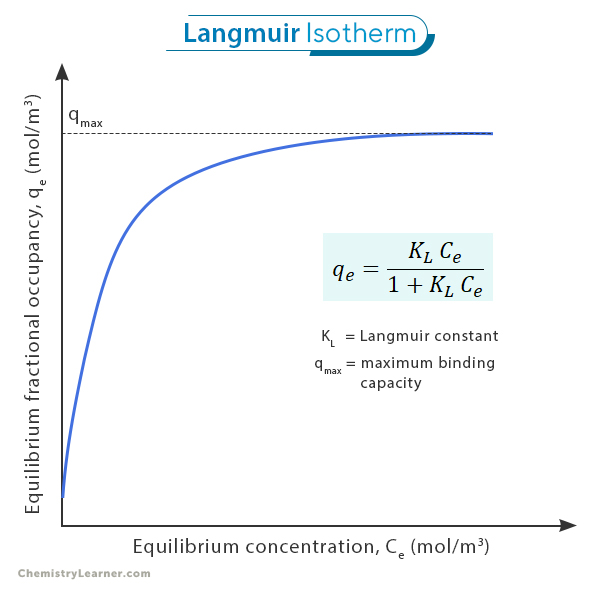Langmuir Isotherm
The Langmuir Isotherm describes the adsorption of a substance onto a solid surface. It defines the relationship between the concentration of an adsorbate (the substance being adsorbed) in solution and its coverage on the surface of an adsorbent (the solid material). It assumes a limited number of identical sites on the surface where molecules can bind or be desorbed. [1-4]
According to this model, as the concentration of the adsorbate increases, more molecules will be attracted to and occupy available sites on the surface. However, as these sites become saturated with molecules, further increase in concentration will have less effect on increasing coverage.
This adsorption model was developed by Irving Langmuir, an American chemist, physicist, engineer, and Nobel laureate in chemistry.
Assumption
It is essential to consider the assumptions of the Langmuir model to interpret its results correctly. [1]
- Adsorption occurs on a homogeneous surface with identical sites available for adsorption. It assumes no variations in surface energy or active sites on the substrate exist.
- Adsorption and desorption processes are reversible and reach equilibrium. It implies that no irreversible reactions or changes occur during adsorption.
- There are no interactions between adsorbed molecules. It means that each molecule independently occupies a site without any influence from neighboring molecules.
- Ideal conditions include uniform temperature throughout the system and constant pressure during adsorption.
While these assumptions simplify the mathematical representation of adsorption, they may only sometimes hold in real-world scenarios. Deviations from these assumptions can occur due to factors like surface heterogeneity, lateral interactions between molecules, or non-equilibrium conditions.
Equation
The Langmuir Isotherm equation quantifies parameters such as maximum coverage (monolayer capacity) and binding affinity (adsorption constant). These parameters are crucial in understanding how different substances interact with solid surfaces. [1-4]
The equation is derived based on the assumption that adsorption occurs on a homogeneous surface with a finite number of identical sites. It relates the equilibrium fractional occupancy of the adsorption sites (qe), which represents the fraction of available sites occupied by adsorbate molecules, to the gas pressure (Pe) or solute concentration (Ce) in equilibrium with the surface.
The Langmuir equation can be expressed as:
qe = (KL * Pe) / (1 + KL * Pe)
or, qe = (KL * Ce) / (1 + KL * Ce)
Here, KL is the Langmuir constant, a measure of how strongly an adsorbate molecule interacts with a specific site on the surface.

Significance
Langmuir Isotherm is particularly significant in studying adsorption equilibrium because it provides insights into factors such as temperature, pressure, and concentration that influence this equilibrium. Scientists can optimize processes like catalysis, gas separation, pollutant removal from water sources, and more by understanding how these factors affect adsorption behavior. [1]
Moreover, the Langmuir equation provides insights into various aspects of adsorption behavior, such as monolayer formation, saturation coverage, and competitive adsorption. Understanding and utilizing the Langmuir equation allows researchers to predict and optimize adsorption processes for various industrial applications. By manipulating experimental conditions and adjusting Langmuir constants, scientists can control factors such as selectivity, capacity, and efficiency in processes involving adsorption phenomena.